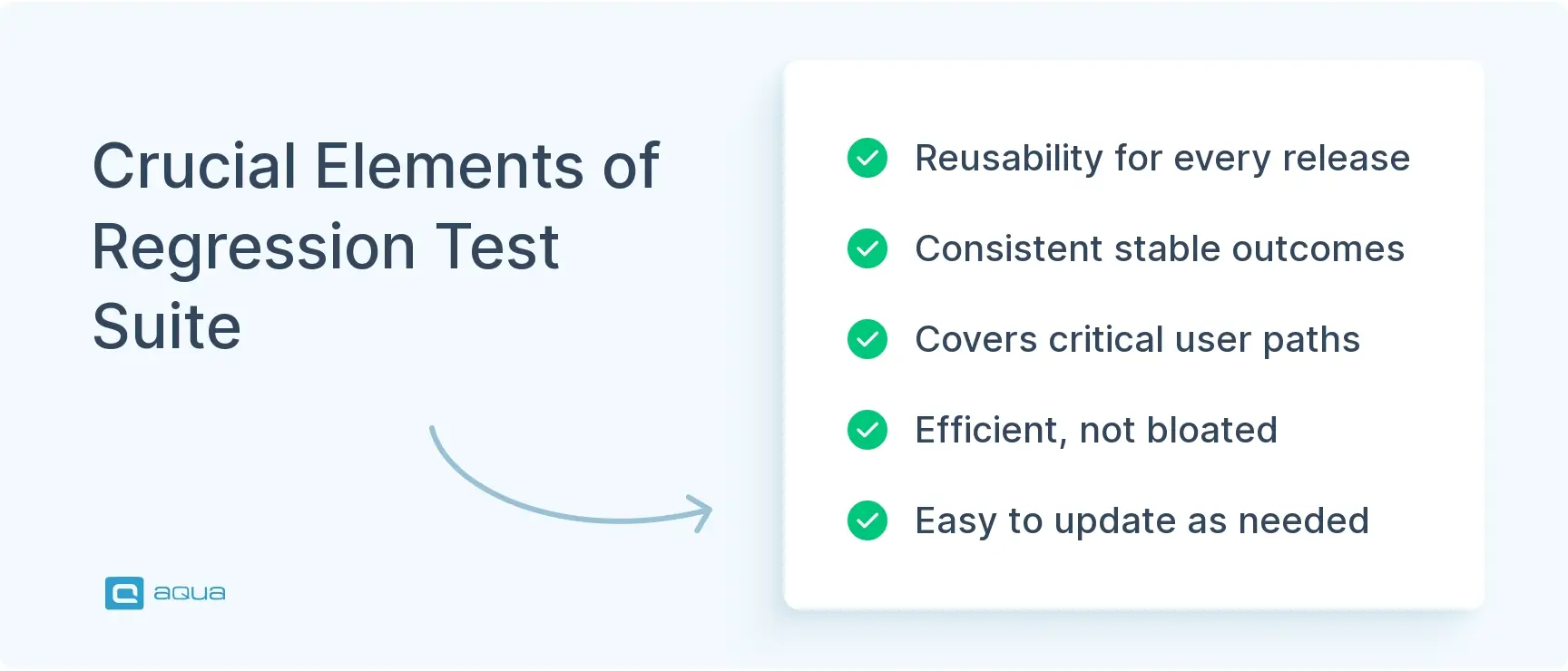What is a Regression Test Suite?
A regression test suite is essentially your collection of test cases designed to verify that code changes haven’t broken existing functionality. Think of it as your “trust but verify” system for your application.
Unlike other types of testing that focus on new features, regression testing looks backwards, making sure what worked before still works now. It’s like having a friend check that you didn’t leave the stove on before heading out the door. Let’s call it a final sanity check that prevents disasters.
Understanding what is regression test suite is crucial for any QA professional. At its core, the regression suite in testing serves as a protective barrier for your software, ensuring that previously developed and tested features continue to work as expected after changes.
Key characteristics of a regression test suite include:
- Reusability: These tests run repeatedly after code changes
- Stability: They should provide consistent results when no relevant code has changed
- Coverage: They target critical paths and functionality that users depend on
- Efficiency: They balance thoroughness with reasonable execution time
- Maintainability: The suite evolves as your application changes

Regression testing becomes your early warning system and alerts you to unintended side effects before they reach production. Without it, you’re crossing your fingers and hoping code changes don’t break anything important, which is not exactly a risk management strategy you’d want to explain to your boss.
Purpose and Scope of Regression Test Suite
Before diving into test case selection, you need to nail down exactly what your regression suite is trying to accomplish. Different teams have different needs, and your approach should reflect that.
The purpose of regression testing is straightforward. The scope? That’s where you need to make strategic decisions based on your specific situation.
Examples of varying scopes include:
1. Full Regression: Testing the entire application after changes. This gives maximum confidence but takes the most time.
When to use: Major releases, significant architectural changes, or before crucial releases
Example: E-commerce site before Black Friday
2. Partial Regression: Testing related modules or features affected by a change.
When to use: Minor releases, when changes affect specific components
Example: Testing the checkout flow after modifying the payment processing module
3. Smoke Regression: Quick validation of core functionality.
When to use: Quick verification after minor fixes, daily builds
Example: Verifying login, search, and purchase functionality after any code change
The right scope depends on your risk tolerance, release frequency, and available resources. A mission-critical financial application might require full regression after any change, while a content site might opt for targeted testing of affected areas.
Remember, no one has unlimited testing time, and your scope decisions directly impact how quickly you can release while maintaining quality.
If you're doing sprint cadence (i.e. internal release every 2 weeks), I would do a smoke/small regression after each sprint to ensure that the core product is still working as intended. If you're doing CI/CD, you'll want to do a full regression BEFORE the button is pressed to go into production. You ABSOLUTELY want to do a full regression/large smoke test after moving into production.
Selecting Test Cases Efficiently for Regression Test Suite
Not all test cases deserve a spot in your regression suite. Being selective is crucial: choose wisely and you’ll catch critical issues without wasting time. Choose poorly and you’ll either miss important bugs or spend way too long testing.
When building your regression suite, you need to do the following:
Start with the money makers: Your login flow, checkout process, data sync, and core user workflows. If these break, your business stops. Everything else is secondary.
Target your problem children: Look at your bug tracking system and identify modules that break repeatedly. These areas have earned their spot in your regression suite through painful experience.
Focus on integration points: APIs, database connections, third-party services, and anywhere two systems shake hands. These are where changes in one area mysteriously break something completely unrelated.
Include your most-used features: Check your analytics; what do 80% of your users actually do? Test those paths religiously and let the edge cases wait for manual testing.
Test what changes most: That module your team touches every sprint? It needs regression coverage. That legacy code nobody dares modify? Probably doesn’t.
A quick reality check: a 30-minute regression suite that runs every deployment beats a 4-hour suite that gets skipped when pressure mounts. Build for the schedule you actually have, not the one you wish you had. You can always add more tests later, but you can’t undo the damage from skipping regression testing entirely.
Here’s where most teams hit a wall: they know which test cases to include, but managing and maintaining a regression suite across multiple environments, test types, and team members becomes a logistical nightmare. You end up with test cases scattered across different tools, inconsistent execution schedules, and no clear visibility into what’s actually been tested. This is exactly the coordination challenge that modern test management platforms solve.
Aqua cloud helps you deal with this chaos. Instead of spreadsheets and multiple tools, you get a centralised hub where all your regression test cases live, execute, and report results automatically. The AI-powered test generation helps you quickly create comprehensive regression tests for those critical business paths. When tests fail, the native bug recording integration Capture catches everything instantly; no more hunting through logs to figure out what went wrong. With full integration to your existing CI/CD pipeline through Jenkins, Azure DevOps, and other tools, your regression suite becomes part of your deployment process, not an afterthought. The result? Complete visibility into your regression testing coverage, automated execution that fits your release schedule, and the confidence that your critical paths are protected every single time you ship code.
Streamline 100% of your regression testing efforts
When prioritising what to test, not everything carries the same weight. That’s where a risk-based approach comes in—helping teams focus on what matters most. Here are a few key criteria to consider when making those decisions: Risk-based selection criteria to consider:
- Impact: How bad would it be if this feature broke?
- Probability: How likely is this area to be affected by changes?
- Usage Frequency: How often do users interact with this feature?
- Complexity: How many moving parts need to work together?
Avoid the trap of just selecting random tests or trying to include everything. A bloated regression suite becomes slow, expensive, and ultimately gets skipped when time is tight, defeating its entire purpose.
Instead, think of your regression test suite as a carefully curated collection that gives you the most quality confidence per minute of testing time. Start with the essentials and expand methodically as needed.
How to Build a Regression Test Suite Step-by-Step
Most teams dive into building regression suites without a plan, then wonder why they end up with a tangled mess of tests that nobody wants to maintain. Here’s an approach that actually works:
- Start by mapping what matters most: Don’t begin with test case management; begin with understanding your application. Spend time identifying the workflows that would cause customer complaints if they broke: user registration, payment processing, and data synchronisation. These become your foundation. Walk through your app like an angry customer would and note every critical interaction.
- Take inventory of what you already have: Before writing new tests, dig through your existing manual test cases and automated scripts. You’ll be surprised how much useful material is already sitting in various spreadsheets and tools. The goal is to identify the gems worth preserving and the redundant tests worth discarding.
- Build your automation framework first: This might seem backwards, but establishing your testing infrastructure before writing individual tests saves massive headaches later. Choose tools that integrate with your existing development workflow, not the fanciest ones on the market. Your framework should make writing new tests easier, not harder.
- Start small and grow strategically: Begin with smoke tests that cover your absolute must-work scenarios: the features that would trigger an emergency rollback if they failed. Once these are solid and running reliably, expand to functional tests for your core features. Resist the urge to test everything immediately.
- Make maintenance part of the process from day one: Every test you add is a test someone will need to update when requirements change. Create clear documentation about what each test does and why it exists. Establish who owns updates when features change. Without this, your regression suite becomes technical debt instead of an asset.
A successful regression suite isn’t built on perfection, it’s built on consistency. A modest suite that runs reliably beats an extensive suite that’s constantly broken or skipped due to maintenance issues.
Maintaining the Regression Test Suite
Even the best regression suite becomes ineffective without proper maintenance. As your application evolves, your test suite needs to keep pace. Otherwise, you’ll end up with useless tests that waste time or miss critical issues.
Regular maintenance activities should include:
- Reviewing Test Relevance: Every 2-3 release cycles, evaluate if each test still provides value
- Updating Expected Results: After intentional feature changes, update test baselines
- Adding Tests for New Features: Incorporate critical paths from new functionality
- Removing Obsolete Tests: Retire tests for deprecated features
- Optimising Slow Tests: Refactor tests that take too long to execute
- Fixing Flaky Tests: Address tests with inconsistent results
Try to fully understand how to maintain a regression test suite is crucial for long-term testing success. A well-maintained regression test suite becomes more valuable over time and catches regressions that might otherwise slip through.
Maintenance Checklist:
- Schedule regular review sessions (monthly/quarterly)
- Track test effectiveness metrics (defect detection rate)
- Monitor test execution times and set acceptable thresholds
- Document reasons for adding or removing tests
- Cross-train team members on suite maintenance
- Validate suite coverage after significant application changes
- Update test data to remain relevant with the current application state
Letting the regression test suite grow without bounds is one of the most common mistakes. Without pruning, your suite becomes a slow, unwieldy monster that teams start avoiding. Remember that more tests aren’t always better, effective, focused tests are what you’re after.
Treat your test suite like a garden: regular pruning and care yield better results than just letting it grow wild.
Letting the regression test suite grow without bounds is one of the most common mistakes in testing. Without regular pruning, it becomes a slow, unwieldy burden that teams start to avoid. More tests don’t always mean better quality: what truly matters is maintaining a focused, effective suite. That’s where Aqua comes in. As a test management solution, Aqua helps teams take back control of their regression testing by offering 100% traceability, full coverage and visibility, a centralised hub for both manual and automated tests, and AI-powered test case generation directly from requirements, making maintenance faster, smarter, and far less painful.
Optimise 100% of your regression testing suite
Best Practices for Effective Regression Testing Suite
Want your regression suite to actually catch issues before they reach your users? These best practices will help you build a suite that delivers real value instead of just checking a process box.
- Design for Isolation: Make sure tests don’t depend on each other’s outcomes. Each test should run independently, with its own setup and teardown procedures. This prevents cascade failures and makes debugging much easier.
- Prioritise Based on Risk and Value: Not all features are created equal. Focus your regression efforts on high-risk areas with business impact. A bug in the checkout flow is usually more critical than a minor UI issue in a rarely used admin screen.
- Combine Automation with Manual Testing: While automation should handle the bulk of regression testing, some scenarios still need human judgment. Create a balanced approach where automation handles repetitive checks while manual testing focuses on exploratory scenarios.
- Keep Execution Time Reasonable: Long-running test suites eventually get skipped. Aim to keep your regression suite execution time appropriate for your release routine. Daily builds need faster feedback than major releases.
- Track Effectiveness Metrics: Monitor how often your regression tests catch actual issues. Tests that never fail might be testing stable code, or they might be too shallow to catch real problems. Adjust accordingly.
Additional best practices:
- Implement parallel test execution where possible
- Use data-driven approaches for testing similar scenarios with different inputs
- Include negative test cases that verify error handling
- Tag tests by feature area, risk level, and execution time for flexible execution
- Review failing tests promptly. Ignoring failures leads to normalised deviance
The most successful regression suites start lean and grow thoughtfully, adding tests based on actual risk rather than theoretical coverage needs. Looking at a regression test suite example from successful projects can also provide valuable insights into effective structure and organisation.
Automation in Regression Testing Suite
Let’s be real: manual regression testing doesn’t scale. As your application grows, automation becomes essential if you want to catch issues without delaying releases or burning out your QA team.
If your regression tests are automated, then ideally you run them on a pull request or branch before merging said branch into master. This prevents regressions from entering your code base.
Regression testing is among the most preferred tests for automation, with 50.5% of organisations prioritising it. That’s because automation provides these key benefits for regression testing:
- Consistency: Tests execute the exact same way every time
- Speed: Machines can run tests much faster than humans
- Coverage: You can test more scenarios in less time
- Early feedback: Tests can run with every code change
- Resource efficiency: Your team can focus on exploratory testing
Here’s a comparison of popular automation tools for regression testing:
| Tool | Best For | Learning Curve | Integration | Strengths | Limitations |
|---|---|---|---|---|---|
| Selenium | Web applications | Moderate | Excellent | Cross-browser, mature ecosystem | Setup complexity, flaky for dynamic content |
| Cypress | Modern JS apps | Low | Good | Fast execution, developer-friendly | Limited cross-browser support |
| Playwright | Cross-browser testing | Low-Moderate | Excellent | Modern API, multiple browsers | Newer ecosystem |
| Appium | Mobile applications | High | Good | Cross-platform mobile | Complex setup, speed |
When implementing automation:
- Start with stable, high-risk areas
- Build modular, reusable components
- Implement proper error handling and reporting
- Use version control for test code
- Run tests in CI/CD pipelines for immediate feedback
Choosing the right tool is just the beginning. The real challenge comes when you’re trying to coordinate tests across multiple tools, manage results from different environments, and keep everything organised as your suite grows. You don’t want to end up with automation scattered across various frameworks, right? Because it’s making it nearly impossible to get a unified view of your regression testing coverage.
This fragmentation is exactly what aqua cloud eliminates. Instead of managing separate tools for different types of testing, you get a unified platform that integrates seamlessly with Selenium, Cypress, Playwright, and your other existing automation frameworks. Your regression test results, whether from web, mobile, or API testing, all flow into one centralised dashboard where you can track coverage, analyse trends, and identify which areas need attention. The AI-powered test generation creates comprehensive regression scenarios in minutes, while native integrations with Jenkins, Azure DevOps, and Jira keep your entire testing workflow connected. It’s time to start managing your regression testing strategy from a single, powerful platform that grows with your needs.
Combine automation frameworks with AI-powered TMS for 100% efficiency of regression testing
Conclusion
Regression testing is a strategic tool that helps teams move faster with confidence. But to stay effective, your suite needs to be maintained with intention. That means avoiding bloated test runs, regularly reviewing and pruning outdated cases, and focusing on what actually protects business-critical functionality. The most successful teams aren’t writing endless tests—they’re managing them smartly. With the right approach, regression testing evolves from a bottleneck into an enabler of fast, reliable releases. And with a test management solution like aqua, maintaining a lean, high-impact regression suite becomes not just manageable, but scalable.


















